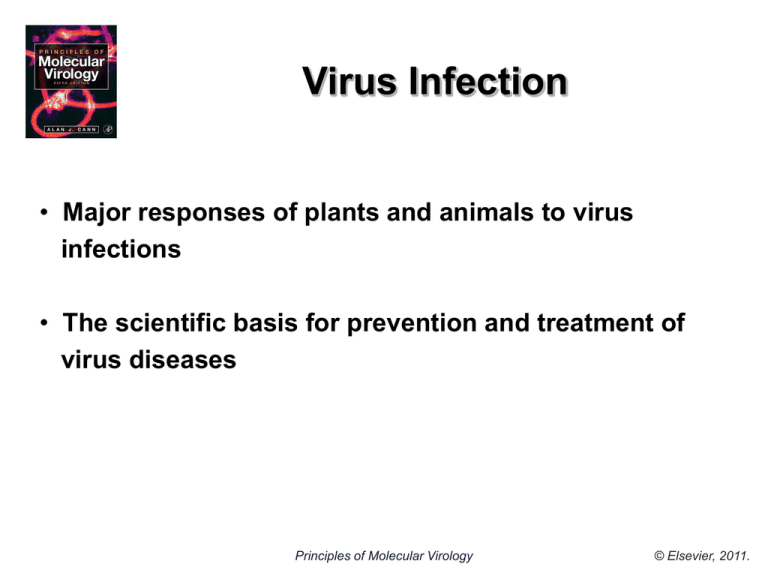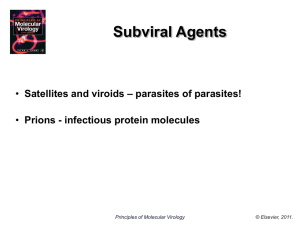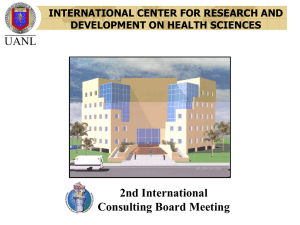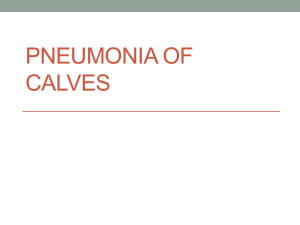Chapter 6
advertisement

Virus Infection • Major responses of plants and animals to virus infections • The scientific basis for prevention and treatment of virus diseases Principles of Molecular Virology © Elsevier, 2011. Transmission of plant viruses • • • • • • • • Mechanical Seeds Vegetative propagation/grafting Vectors Bacteria (e.g. Agrobacterium tumefaciens - Ti plasmid) Fungi Nematodes Arthropods: – insects – arachnids Principles of Molecular Virology © Elsevier, 2011. Movement Proteins Principles of Molecular Virology © Elsevier, 2011. Symptoms of virus infection in plants • Growth retardation • Distortion • Mosaic patterning on leaves • Yellowing • Wilting Resulting from: – Necrosis – Hypoplasia – Hyperplasia Principles of Molecular Virology © Elsevier, 2011. The hypersensitive response • Pathogenesis-related (PR) proteins • Production of cell wall phenolic substances • Release of active oxygen species • Production of phytoalexins • Accumulation of salicylic acid Principles of Molecular Virology © Elsevier, 2011. Virus-resistant plants • Traditional plant breeding • Transgenic plants expressing: – Virus coat proteins – Intact or partial virus replicases – Antisense RNAs – Defective virus genomes – Satellite sequences – Catalytic RNA sequences (ribozymes) – Modified movement proteins Principles of Molecular Virology © Elsevier, 2011. Immune Responses to Virus Infections in Animals Humoral immune response Principles of Molecular Virology © Elsevier, 2011. Cell-mediated immunity Principles of Molecular Virology © Elsevier, 2011. Recognition of virus-infected cells Principles of Molecular Virology © Elsevier, 2011. Viruses and Apoptosis Principles of Molecular Virology © Elsevier, 2011. Interferons 1957, Alick Issacs and Jean Lindenmann Principles of Molecular Virology © Elsevier, 2011. Different types of interferon (IFN) • IFN-α • IFN-β • Other interferons Principles of Molecular Virology © Elsevier, 2011. Induction of interferon synthesis • Virus infection • Double-stranded (ds) RNA • Metabolic inhibitors Principles of Molecular Virology © Elsevier, 2011. Interferon Antiviral Mechanisms Induction of 2',5'-oligo A synthetase Principles of Molecular Virology © Elsevier, 2011. Interferon Antiviral Mechanisms Activation of PKR Principles of Molecular Virology © Elsevier, 2011. Evasion of Immune Responses by Viruses • Inhibition of MHC-I-restricted antigen presentation • Inhibition of MHC-II-restricted antigen presentation • Inhibition of natural killer cell lysis • Interference with apoptosis • Inhibition of cytokine action • Evasion of humoral immunity • Evasion of the complement cascade Principles of Molecular Virology © Elsevier, 2011. Virus–Host Interactions Site of virus entry into the body Principles of Molecular Virology © Elsevier, 2011. Transmission of viruses through the environment Principles of Molecular Virology © Elsevier, 2011. Local infection Virus infection of polarized epithelial cells Principles of Molecular Virology © Elsevier, 2011. Outcome of infection • • • • Clearance vs. persistence Antigenic variation Antigenic drift Antigenic shift Principles of Molecular Virology © Elsevier, 2011. The Course of Virus Infections • • • • • Abortive Infection Acute Infection Chronic Infection Persistent Infection Latent Infection Principles of Molecular Virology © Elsevier, 2011. Prevention and Therapy of Virus Infection • Drugs (cure) versus vaccines (prevention) – Synthetic vaccines – Recombinant vaccines – DNA vaccines – Subunit vaccines – Virus vectors are recombinant viruses – Inactivated vaccines – Attenuated vaccines Principles of Molecular Virology © Elsevier, 2011. RNA interference (RNAi) Principles of Molecular Virology © Elsevier, 2011. Virus Vectors and Gene Therapy • Delivery of large biomolecules to cells • The possibility of targeting a specific cell type • High potency of action due to replication of vector • Potential to treat cancer Principles of Molecular Virology © Elsevier, 2011. Chemotherapy of Virus Infections Chemotherapeutic index: Dose of drug that inhibits virus replication Dose of drug that is toxic to host • The process targeted by a drug must be essential for replication • The drug is active against the virus but has ‘acceptable toxicity’ to the host Principles of Molecular Virology © Elsevier, 2011. Chemotherapy of Virus Infections • Attachment • Penetration/uncoating - Amantadine • Genome replication Acyclovir, reverse transcriptase inhibitors • Gene expression, release - ? • Maturation - protease inhibitors Principles of Molecular Virology © Elsevier, 2011. Summary Virus infection is a complex, multistage interaction between the virus and the host organism. The course and outcome of any infection are the result of a balance between host and virus. Host factors include route of virus transmission and the immune response. Virus processes include site of initial infection, spread throughout the host, regulation of gene expression to evade the immune response. Principles of Molecular Virology © Elsevier, 2011. Further Reading Aliyari, R. & Ding S.W. (2009) RNA-based viral immunity initiated by the Dicer family of host immune receptors. Immunol Rev. 227(1): 176-188 Crotty, S. and Andino, R. (2002) Implications of high RNA virus mutation rates: lethal mutagenesis and the antiviral drug ribavirin. Microbes and Infection, 4: 1301–1307 Coiras, M., López-Huertas, M.R., Pérez-Olmeda, M. and Alcamí, J. (2009) Understanding HIV-1 latency provides clues for the eradication of long-term reservoirs. Nat Rev Microbiol. 7(11): 798-812 Cullen, B.R. (2010) Five Questions about Viruses and MicroRNAs. PLoS Pathog 6(2): e1000787 Ding, S.W. & Voinnet. O. (2007) Antiviral immunity directed by small RNAs. Cell 130(3): 413-426 Kindt, T.J., Goldsby, R.A., Osborne, B.A. & Kuby, J. (2007) Kuby Immunology. W.H. Freeman, ISBN 1429202114. Kutzler, M.A. & Weiner, D.B. (2008) DNA vaccines: ready for prime time? Nature Reviews Genetics 9: 776-788 Lisnića, V.J., Krmpotića, A. and Jonjića, S. (2010) Modulation of natural killer cell activity by viruses. Current Opinion in Microbiology 13(4): 530-539 Liu, T.C. & Kirn, D. (2008) Gene therapy progress and prospects cancer: oncolytic viruses. Gene Ther 15(12): 877-884 Lu, L.F. & Liston A. (2009) MicroRNA in the immune system, microRNA as an immune system. Immunology 127(3): 291298 Mallery, D.L. et al (2010) Antibodies mediate intracellular immunity through tripartite motif-containing 21 (TRIM21) PNAS USA 107(46): 19985-19990 Palese P. (2006) Making better influenza virus vaccines? Emerg Infect Dis. http://www.cdc.gov/ncidod/EID/vol12no01/051043.htm Randall, R.E. and Goodbourn, S. (2008) Interferons and viruses: an interplay between induction, signalling, antiviral responses and virus countermeasures. J Gen Virol. 89(1) Sen, G.C. (2001) Viruses and interferons. Annual Review of Microbiology, 55: 255–281 Tortorella, D. et al. (2000) Viral subversion of the immune system. Annual Review of Immunology, 18: 861–926 Welsh, R.M. et al. (2004) Immunological memory to viral infections. Annual Review of Immunology, 22: 711–743 Principles of Molecular Virology © Elsevier, 2011.






